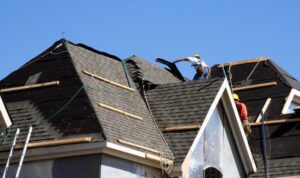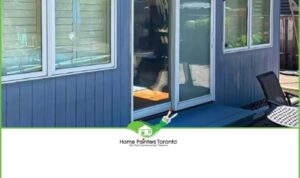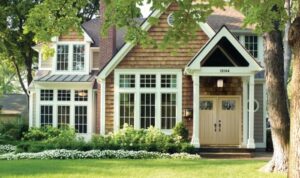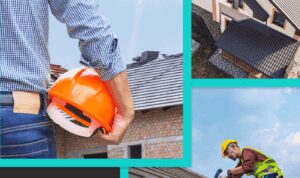Delving into the world of slate roofing pros and cons, this guide aims to provide a detailed look at the benefits and drawbacks of this roofing option. From its durability to aesthetic appeal, we cover it all in a manner that is informative and engaging.
Moving forward, we will delve into the specifics of slate roofing, shedding light on its maintenance, repairs, environmental impact, and more.
Pros of Slate Roofing
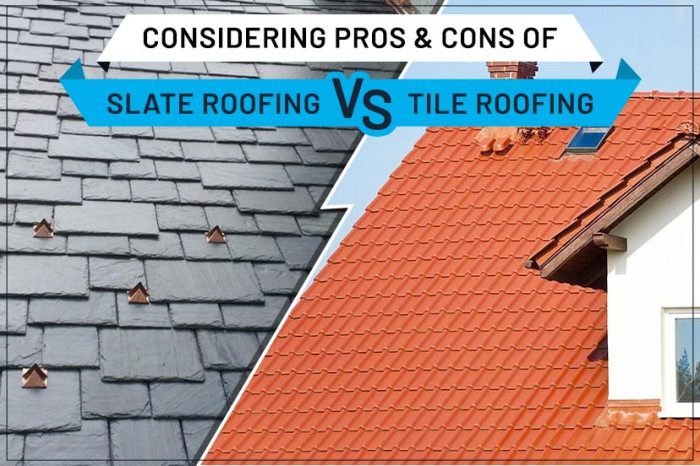
Slate roofing offers numerous advantages that make it a popular choice for homeowners.
Durability of Slate Roofing
Slate roofs are known for their exceptional durability, lasting up to 100 years or more with proper maintenance. They are resistant to rot, mold, and insects, making them a long-term investment for homeowners.
Aesthetic Appeal of Slate Roofs
One of the standout features of slate roofing is its timeless and elegant appearance. The natural beauty of slate tiles adds a touch of sophistication to any home, enhancing its curb appeal and overall value.
Eco-Friendly Advantages of Using Slate
Slate is a natural material that is sustainable and environmentally friendly. It is recyclable and requires minimal processing during production, reducing its impact on the environment. Additionally, slate roofs can help improve energy efficiency by providing natural insulation, reducing the need for heating and cooling.
Comparison of Lifespan with Other Materials
When compared to other roofing materials like asphalt shingles or wooden shakes, slate roofing stands out for its longevity. While traditional roofing materials may need to be replaced every 20-30 years, slate roofs can last a century or more, saving homeowners money in the long run.
Cons of Slate Roofing
Installing a slate roof comes with several drawbacks that homeowners should consider before making a decision. From the high initial cost to the limited color options, there are certain factors that may make slate roofing less appealing to some individuals.
High Initial Cost
- Slate roofing is one of the most expensive roofing materials on the market, with costs ranging from $600 to $1,500 per square foot.
- The high cost of materials and specialized labor can make it unaffordable for some homeowners, especially those on a tight budget.
Potential Weight Issues
- Slate roofs are significantly heavier than other roofing materials, such as asphalt shingles or metal.
- The weight of slate can put a strain on the structure of a house, requiring additional reinforcement to support the roof properly.
Specialized Installation and Maintenance
- Installing a slate roof requires specialized knowledge and skills, as well as experienced professionals who are familiar with the unique challenges of working with slate.
- Ongoing maintenance is also crucial to ensure the longevity of a slate roof, which may involve regular inspections and repairs by professionals.
Limited Color Options
- Compared to other roofing materials that offer a wide range of colors and finishes, slate roofing has limited options available.
- Homeowners looking for specific colors or styles may find it challenging to achieve their desired aesthetic with slate roofing.
Maintenance and Repairs

Maintaining and repairing a slate roof is essential to ensure its longevity and performance. Here, we will discuss the typical maintenance requirements, common issues, repair processes, and tips for prolonging the lifespan of a slate roof.
Maintenance Requirements for Slate Roofs
- Regular inspections to check for cracked, broken, or missing slates
- Cleaning debris and moss to prevent water damage
- Checking and repairing flashing to prevent leaks
- Ensuring proper ventilation in the attic to prevent moisture buildup
Common Issues and Solutions
- Slates shifting or slipping: Secure loose slates and replace damaged ones
- Water leaks: Identify the source of the leak and repair the damaged area
- Moss and algae growth: Clean the roof regularly and trim overhanging trees
Repair Process for Slate Roofs vs Other Materials
Repairing a slate roof involves carefully removing damaged slates, replacing them with new ones, and ensuring proper alignment and sealing. Compared to other roofing materials, slate roofs require specialized tools and skills, making the repair process more intricate and time-consuming.
Tips for Prolonging the Lifespan of a Slate Roof
- Regular maintenance and inspections can help identify and address issues promptly
- Avoid walking on the roof to prevent damaging the slates
- Trim overhanging branches to prevent debris buildup on the roof
- Keep gutters clean to ensure proper drainage and prevent water damage
Environmental Impact
Slate roofing offers several environmental benefits that make it a sustainable choice for homeowners. From its durability to energy efficiency, slate roofs have a positive impact on both the environment and your wallet.
Sustainability of Slate as a Roofing Material
Slate is a natural stone that is quarried from the earth without the need for extensive processing or chemical treatments. This makes it a sustainable roofing material as it does not contribute to pollution during its production. Additionally, slate roofs can last for over 100 years, reducing the need for frequent replacements and further minimizing environmental impact.
Energy Efficiency of Slate Roofs
Slate roofs are known for their high thermal mass, which helps regulate indoor temperatures and reduce the need for heating or cooling. This energy efficiency can lead to lower energy bills and a decreased carbon footprint, making slate roofs a sustainable choice for environmentally conscious homeowners.
Recyclability of Slate Roofing Materials
While slate roofs have a long lifespan, when they do eventually need to be replaced, the materials can be recycled and reused. This reduces the amount of waste that ends up in landfills and promotes a more circular economy where resources are conserved and reused.
Environmental Footprint of Slate Roofing vs. Other Options
Compared to other roofing materials like asphalt shingles or metal roofs, slate has a lower environmental footprint. Its longevity, recyclability, and energy efficiency all contribute to a more eco-friendly choice for homeowners looking to reduce their impact on the environment.
Final Conclusion
Wrapping up our exploration of slate roofing pros and cons, we have uncovered a wealth of information that highlights the strengths and weaknesses of this roofing material. Whether you're considering slate for your home or are simply curious, this guide offers valuable insights to aid in your decision-making process.
User Queries
What is the average lifespan of a slate roof?
The average lifespan of a slate roof can exceed 100 years, making it a highly durable roofing option.
Are there any color options available for slate roofing?
While slate roofing typically comes in natural colors like gray, black, and green, some manufacturers offer custom colors as well.
How does the energy efficiency of slate roofs compare to other roofing materials?
Slate roofs are known for their excellent energy efficiency, helping to regulate temperature and reduce heating and cooling costs.
What are the common maintenance requirements for slate roofs?
Regular inspections, replacing broken tiles, and keeping the roof clean are common maintenance tasks for slate roofs.
Is slate roofing environmentally friendly?
Yes, slate is a sustainable roofing material due to its longevity, natural composition, and recyclability.

